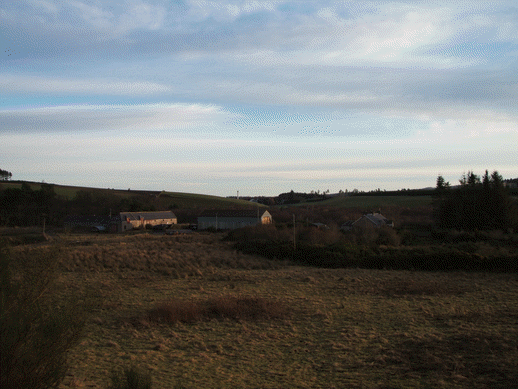Elgin Deanery
Hospital at Bogside
Hospital : OS Ref. NGR: NJ 202572 H.E.S. No: (no record) Dedication: St John the Baptist.
There is little doubt that, at some point in the medieval period, a hospital was founded at Bogside but information about it is sparse. H.B. Mackintosh recorded - "Then we have Bogside, the site of a Hospital in connection with the early Church of Birnie."4 Lachlan Shaw wrote, "On the lands of Bogside there formerly stood an Hospital and Chapel dedicated to St John the Baptist, but no date can be given. It is said that one of the tenants carried off the stones to construct 'rumbling drains' on the farm, a general fate which befell ecclesiastical and castellated buildings."8
Of course, the lands of Bogside (sometimes called the Haughs of Bogside) were situated at an important and ancient crossing of the River Lossie at Cloddach

King Alexander I. gifted the lands of Manbeen and Kellas to the Church and Bishop Andrew de Moravia included them in endowments which he gave to the Maison Dieu in Elgin.9 There is a charter recording an agreement between Andrew, Bishop of Moray, and the bretheren of the Domus Dei in Elgin, determining the ownership of a portion of the lands of Manbeen - both parties had previously laid claim to these lands - and it is to be assumed that the 'portion' referred to constituted what was then known as Bogside.
The lands of Manbeen (Upper and Nether) and Bogside belonged, then, to the Preceptory of the Maison Dieu. A Charter of King Charles I., given on 8 October 1633, confirms a substantial inventory of the lands belonging to the Hospital of Maison Dieu in the town of Elgin, including "the lands of Bogside, with the mill thereof, mill lands, adstricted multures and sequels."10 The mill on the Bogside lands should not be confused with the Mill of Birnie (a corn mill), which lay on the opposite (east) side of the River Lossie, directly opposite the Bogside properties at
In the period immediately after the Reformation, there are three instances of the miller at Bogside being reprimanded by the Kirk Session for grinding corn on the Sabbath - Patrick Myll, 30th August, 1604; Elchinar Hay, 27th September, 1616; Alexander Catenoche, 22nd September, 1629. This was a very common entry in the Kirk Session records of the time and it is obvious that many millers worked on a Sunday if they could get away with it. The dates show that the harvest would have been in full swing and it would have been difficult for the miller to keep up with the work they would have had at hand at this time. We can have some sympathy for their trying to keep up by working on a Sunday in spite of the chance of being reprimanded by the Kirk!12
Medieval Charter Evidence.
| Date | Details |
|---|---|
| 23 February 1235 | RRS, iii, no. 216; POMS 1/7/223. |
| Charter of King Alexande II stating that he has given to the Hospital of Elgin, for the support of the poor there, his lands of Manbeen and Kellas, paying suit to the king's mill at Elgin. | |
| 1237 | Moray Reg., no. 39, p. 33-34. |
| Settlement between Andrew, Bishop of Moray, and the brothers of the Maison Dieu of Elgin, over certain lands said to be part of Manbeen which King Alexander I (had gifted to them. Both the bishop and the brothers had claimed the land as belonging to them. It was agreed that the land would, in future, belong to the brothers in free, pure and/or prepetual alms. They agreed that the water of the River Lossie would belong equally to the Maison Dieu (west bank)and the church of Birnie (east bank). [Kellas is mentioned, but Bogside is not, although it is implied by "the west bank of the Lossie."] | |
| 20 April 1343 | Moray Reg., no. 114, pp. 126-127 |
| Bishop John Pilmore (1326-162) confirms that he had inspected a charter of King David II (1329-1371) in which he confirmed the charter of King Alexander II (d.1249) wherein the king gifted his lands of Manbeen and Kellas to the Maison Dieu in Elgin to provide them with income to use for the sustenation of the poor, paying suit to the king's mill at Elgin. |
4. Mackintosh (1924), p. 49. Return to Text
8. Shaw (1882), i., p. 353-4; iii., p. 395. Return to Text
9. REM., no. 114, pp. 126-127. Return to Text
10. Shaw (1882), i., pp. 354, 357; Shaw (1882), iii., p. 205-206. (sequel = 'A duty consisting of a small quantity of grain levied from each consignment ground at a mill, as a perquisite for the miller's servants.') Return to Text
12. Cramond (1908), pp. 127, 149, 211. Return to Text
13. REM., no. 114, pp. 126-127. Return to Text
Cramond, Wm. (1903) The Records of Elgin, 1234-1800, Volume 1, Aberdeen: printed for the New Spalding Club.
Cramond, Wm. (1908) The Records of Elgin, 1234-1800, Volume 2, Aberdeen: printed for the New Spalding Club.
Innes, C. (1837) Registrum Episcopatus Moraviensis: e pluribus codicibus consarcinatum virca A.D. MCCCC, cum continuatione diplomatum recentiorum usque ad A.D. MDCVVIII, Edinburgh: for the Bannatyne Club. [REM]
Mackintosh, H.B. (1924) Pilgrimages in Moray: a guide to the County, Elgin: W.R. Walker & Co., "Courant and Courier" Office.
Shaw, L. (1882) The History of the Province of Moray, Enlarged and brought down to the Present Times by J.F.S. Gordon, Glasgow: Thomas D. Morison, in 3 volumes.
e-mail: cushnieent@gmail.com
© 2023 Cushnie Enterprises
